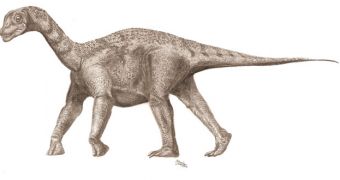These beasts made an elephant look like a mouse. Sauropod dinosaurs were big, but the titanosaurs were the biggest of all. Argentinosaurs, a South American titanosaur, was the largest and heaviest land animal ever. It lived in South America during the middle of the Cretaceous Period (around 100 million years ago). Argentinosaurus was 26 m (87 ft) tall and weighed 100 tons, while Bruhathkayosaurus from India could reach 34 m (113 ft) and 180 tons, as big and heavy as the largest blue whales.
Titanosaurs had bony scales spread over their skins, but their role was not known. A recent analysis of titanosaur embryos suggest that the scales could have defended the giants while they were still defenseless young.
Paleontologist Thiago Marinho at the Federal University of Rio de Janeiro made the research on titanosaur eggs found in Patagonia (Argentina) in 1997. The embryos within displayed bumps on their skin, similar to skin patches found in alligator embryos. This means that the dinosaur bumps developed into bony scales (osteoderms). Osteoderms found on adult titanosaurs were too small and spongy to represent a real defense.
"Such armor would have proven especially helpful for young titanosaurs, since no fossil evidence exists that titanosaurs displayed much in the way of parental care. Although the titanosaurs comprise some of the biggest land animals to walk on Earth, we have to keep in mind that they were born from eggs 30 centimeters [12 inches] in diameter," Marinho said. Such eggs delivered hatchlings no larger than 1 foot (1 m).
They "wouldn't stand a chance against big theropod dinosaurs. But they might have had an effective defense system against small theropods and terrestrial crocodyliforms if they had a cuirass [protective covering] composed by side-by-side osteoderms."
"As titanosaurs grew, they absorbed as much calcium as they could to form their massive skeletons, including from their osteoderms, making these bony scales more porous and spongy. Extant crocodilians, especially juveniles and young adults, do absorb calcium from their osteoderms when their diets do not supply the calcium demand for their metabolism," explained Marinho.
With the increasing size of the older dinosaurs, the bony scales "would have become obsolete accessories, as the size of the titanosaurs was itself a defense system."
Other dinosaur known to have had osteoderms was a carnivorous theropod, Carnotaurus. This suggests that young or embryonic theropod skin could have been protected by osteoderms, too.

 14 DAY TRIAL //
14 DAY TRIAL //